Catherine Eddowes
Catherine Eddowes (14 April 1842 – 30 September 1888) is the fourth of the canonical five victims of the notorious unidentified serial killer known as Jack the Ripper, who is believed to have killed and mutilated a minimum of five women in the Whitechapel and Spitalfields districts of London from late August to early November 1888.[2] Eddowes was the second person murdered in the early hours of Sunday 30 September; a night which already had seen the murder of Elizabeth Stride less than an hour earlier. These two murders are commonly referred to as the "double event".[3]
Catherine Eddowes | |
|---|---|
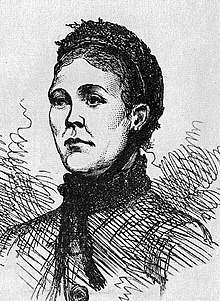 13 October Penny Illustrated Paper portrait of Catherine Eddowes | |
| Born | 14 April 1842 Wolverhampton, Staffordshire, England |
| Died | 30 September 1888 (aged 46) City of London, England |
| Cause of death | Haemorrhage due to severance of the left common carotid artery[1] |
| Body discovered | South corner of Mitre Square in Whitechapel 51.5138°N 0.078°W |
| Resting place | City of London Cemetery, Newham, London, England 51.55792°N 0.04449°W (approximate) |
| Occupation | Casual prostitute |
| Known for | Victim of serial murder |
| Partner(s) | Thomas Conway; John Kelly |
| Children | 3 |
| Parent(s) | George Eddowes Catherine (née Evans) |
Part of a left kidney was later sent to the leader of the Whitechapel Vigilance Committee accompanied by a letter addressed From Hell. The author of this letter claimed the section of kidney was from Eddowes, whose left kidney had been removed. Most experts, however, do not believe this kidney actually originated from Eddowes's body.
Early life
Catherine Eddowes (also known as "Kate Conway" and "Kate Kelly" after her two successive common-law husbands) was born in Graiseley Green, Wolverhampton on 14 April 1842. Her parents were tinplate worker George Eddowes and his wife, Catherine (née Evans). The family moved to London a year after her birth, and her mother ultimately bore 10 other children.
By 1857, both of Eddowes's parents had died,[4] resulting in Eddowes being admitted as an orphan to a Bermondsey Workhouse.[5] She later returned to Wolverhampton where an aunt obtained employment for her as a tinplate stamper at the Old Hall Works. Eddowes was soon fired from this employment, possibly due to her having been caught stealing. She is known to have relocated from Wolverhampton to Birmingham, where she briefly lived with an uncle. Eddowes worked as a tray polisher in Birmingham for four months before returning to Wolverhampton. Nine months later, she again relocated to Birmingham.[6]
While residing in Birmingham, she began a relationship with a former soldier named Thomas Conway, with whom she had two children.[7] At one stage in this relationship, Eddowes had a tattoo of the initials of her common-law husband ("TC") inscribed in blue ink upon her left forearm.[8]
Eddowes was five feet tall, with dark auburn hair and hazel eyes. Friends would later describe her as "a very jolly woman, always singing"[9] and an "intelligent and scholarly (individual), but possessed of a fierce temper."[8]
Relocation to London
In 1868, Eddowes and Conway relocated to London, taking lodgings in Westminster. A third child was born.[10]
While in London, Eddowes took to drinking. She left her family in 1880. By the following year, she was living with a new partner named John Kelly at Cooney's common lodging-house at 55 Flower and Dean Street, Spitalfields, at the centre of London's most notorious criminal rookery. Here she took to casual sex work to pay the rent.[11] To avoid contact with his former partner, Conway drew his army pension under the assumed name of Quinn, and kept their sons' addresses secret from her.[12]
On occasions when Eddowes lacked sufficient money to pay for a bed in a common lodging-house, she is believed to have slept rough in the front room of 26 Dorset Street, known locally as "the shed".[13]
1888
In the summer of 1888, Eddowes, Kelly, and a friend named Emily Birrell took casual work hop-picking in Kent. At harvest's end they returned to London and quickly spent their pay. Eddowes and Kelly split their last sixpence between them; he took fourpence to pay for a bed in the common lodging-house, and she took twopence, just enough for her to stay a night at Mile End Casual Ward in the neighbouring parish.[14]
29 September
In the early afternoon of 29 September, Eddowes told Kelly she would go to Bermondsey to try to get some money from her daughter, Annie Phillips,[15] who was married to a gun-maker in Southwark.[16] With money from pawning his boots, a bare-footed Kelly took a bed at the lodging-house just after 8:00 p.m., and according to the deputy keeper remained there all night.[17]
At 8:30 p.m. on Saturday, 29 September, Eddowes was found lying drunk in the road on Aldgate High Street by PC Louis Robinson. She was taken into custody and then to Bishopsgate police station, where she was detained, giving the name "Nothing", until she was sober enough to leave at 1:00 a.m. on the morning of 30 September.[18]

30 September
Prior to her release, Eddowes gave her name and address as "Mary Ann Kelly of 6 Fashion Street".[19]
Upon leaving the station, instead of turning right to take the shortest route to her home in Flower and Dean Street, Eddowes turned left in the general direction of Aldgate.[20] She was last seen alive at 1:35 a.m. by three witnesses, Joseph Lawende, Joseph Hyam Levy and Harry Harris, who themselves had just left a club on Duke Street.[21] She was standing talking with a man at the entrance to Church Passage, which led south-west from Duke Street to Mitre Square along the south wall of the Great Synagogue of London. Only Lawende could furnish a description of the man, whom he described as a fair-moustached man wearing a navy jacket, peaked cloth cap, and red scarf.[22] Chief Inspector Donald Swanson intimated in his report that Lawende's identification of the woman as Eddowes was doubtful. He wrote that Lawende had said that some clothing of the deceased's that he was shown resembled that of the woman he saw[23]—"which was black ... that was the extent of his identity [sic]".[24] A patrolling policeman, PC James Harvey, walked down Church Passage from Duke Street very shortly afterwards but his beat took him back down Church Passage to Duke Street, without entering the square.[25]
Murder
At 1:45 a.m., Eddowes's mutilated body was found in the south-west corner of Mitre Square by the square's beat policeman PC Edward Watkins.[26][n 1] Watkins was to state that he entered the square at 1:44 a.m. having previously been there at 1:30 a.m. He called for assistance at a tea warehouse in the square, where night watchman George James Morris, who was an ex-policeman, had noticed nothing unusual.[28] Neither had another watchman (George Clapp) at 5 Mitre Square or an off-duty policeman (Richard Pearse) at 3 Mitre Square.[29]
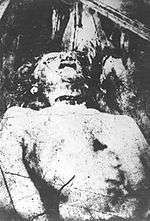
Post-mortem
The subsequent post-mortem records of police surgeon Dr. Frederick Gordon Brown—who arrived at the crime scene after 2:00 a.m.—state:
The body was on its back, the head turned to left shoulder. The arms by the side of the body as if they had fallen there. Both palms upwards, the fingers slightly bent. A thimble was lying off the finger on the right side. The clothes drawn up above the abdomen. The thighs were naked. Left leg extended in a line with the body. The abdomen was exposed. Right leg bent at the thigh and knee.
The bonnet was at the back of the head—great disfigurement of the face. The throat cut. Across below the throat was a neckerchief. ... The intestines were drawn out to a large extent and placed over the right shoulder—they were smeared over with some feculent matter. A piece of about two feet was quite detached from the body and placed between the body and the left arm, apparently by design. The lobe and auricle of the right ear were cut obliquely through. There was a quantity of clotted blood on the pavement on the left side of the neck round the shoulder and upper part of the arm, and fluid blood-coloured serum which had flowed under the neck to the right shoulder, the pavement sloping in that direction.
Body was quite warm. No death stiffening had taken place. She must have been dead most likely within the half hour. We looked for superficial bruises and saw none. No blood on the skin of the abdomen or secretion of any kind on the thighs. No spurting of blood on the bricks or pavement around. No marks of blood below the middle of the body. Several buttons were found in the clotted blood after the body was removed. There was no blood on the front of the clothes. There were no traces of recent connection.[31]
Brown conducted a post-mortem upon Eddowes's body that afternoon, noting:
After washing the left hand carefully, a bruise the size of a sixpence, recent and red, was discovered on the back of the left hand between the thumb and first finger. A few small bruises on right shin of older date. The hands and arms were bronzed. No bruises on the scalp, the back of the body, or the elbows. ... The cause of death was haemorrhage from the left common carotid artery. The death was immediate and the mutilations were inflicted after death ... There would not be much blood on the murderer. The cut was made by someone on the right side of the body, kneeling below the middle of the body. ... The peritoneal lining was cut through on the left side and the left kidney carefully taken out and removed. ... I believe the perpetrator of the act must have had considerable knowledge of the position of the organs in the abdominal cavity and the way of removing them. The parts removed would be of no use for any professional purpose. It required a great deal of knowledge to have removed the kidney and to know where it was placed. Such a knowledge might be possessed by one in the habit of cutting up animals. I think the perpetrator of this act had sufficient time ... It would take at least five minutes. ... I believe it was the act of one person.[32]
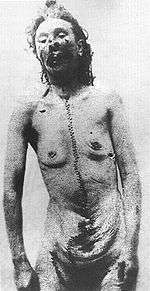
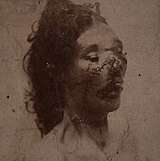
Eddowes was killed and mutilated in the square between 1:35 and 1:45 a.m.[33] Police physician Thomas Bond, disagreed with Brown's assessment of the killer's skill level. Bond's report to police stated: "In each case the mutilation was inflicted by a person who had no scientific nor anatomical knowledge. In my opinion he does not even possess the technical knowledge of a butcher or horse slaughterer or any person accustomed to cut up dead animals."[34] Local surgeon Dr George William Sequeira, who was the first doctor at the scene, and City medical officer William Sedgwick Saunders, who was also present at the autopsy, also thought that the killer lacked anatomical skill and did not seek particular organs.[35] In addition to the abdominal wounds, the murderer had cut Eddowes's face: across the bridge of the nose, on both cheeks, and through the eyelids of both eyes. The tip of her nose and part of one ear had been cut off.
The Royal London Hospital on Whitechapel Road preserves some contemporary crime scene drawings and plans of the Mitre Square murder by the City Surveyor Frederick Foster;[36] they were first brought to public attention in 1966 by Francis Camps, Professor of Forensic Medicine at London University.[37] Based on his analysis of the surviving documents, Camps concluded that "the cuts shown on the body could not have been done by an expert."[38]
The Eddowes inquest was opened on 4 October by Samuel F. Langham, coroner for the City of London,[39] at the City of London Mortuary.[40] A house-to-house search was conducted but nothing suspicious was discovered. Brown stated his belief that Eddowes was killed by a slash to the throat as she lay on the ground, and then mutilated.[41]
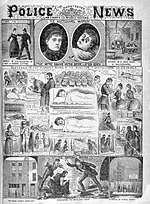
Investigation
A mustard tin containing two pawn tickets issued to Emily Birrell and Anne Kelly was discovered among Eddowes's personal possessions. These eventually led to her identification by John Kelly as his common-law wife, after he read about the tickets in the newspapers.[42] His identification was confirmed by Catherine Eddowes's sister, Eliza Gold.[43] No money was found on her.[44] Though the murder occurred within the City of London, it was close to the boundary of Whitechapel where the previous Whitechapel murders had occurred. The mutilation of Eddowes's body and the abstraction of her left kidney and part of her womb by her murderer bore the signature of Jack the Ripper and was very similar in nature to that of earlier victim Annie Chapman.[3]
Due to the location of Mitre Square, the City of London Police under Detective Inspector James McWilliam joined the murder enquiry alongside the Metropolitan Police who had been engaged in the previous murders. At about 3 a.m. on the same day as Eddowes was murdered, a blood-stained fragment of her apron contaminated with fecal matter was found lying in the passage of the doorway leading to Flats 108 and 119, Model Dwellings, Goulston Street, Whitechapel. Above it on the wall was a graffito in chalk commonly held to have read: "The Juwes are the men that Will not be Blamed for nothing".[45] The writing may or may not have been related to the murder, but either way it was washed away before dawn on the orders of Metropolitan Police Commissioner Sir Charles Warren, who feared that it would spark anti-Jewish riots.[46] Mitre Square had three connecting streets: Church Passage to the north-east, Mitre Street to the south-west, and St James's Place to the north-west. As PC Harvey saw no-one from Church Passage, and PC Watkins saw no-one from Mitre Street, the murderer must have left the square northwards through St James's Place towards Goulston Street.[47] Goulston Street was within a quarter of an hour's walk from Mitre Square, on a direct route to Flower and Dean Street where Eddowes lived, hinting that her murderer also resided nearby and headed back there after the killing.[48]
Major Henry Smith, acting Commissioner of the City Police, claimed in his memoirs to have discovered bloodied water in a public sink in a court off Dorset Street, and as the water was slowly running out of the basin, he calculated that the Ripper had been there only moments before. Ripper author Martin Fido thought it unlikely that the culprit would wait to wash his hands in a semi-public place about forty minutes after the crime, and Smith's memoirs are both unreliable and embellished for dramatic effect.[49] There is no mention of the sink in the official police reports.[50]
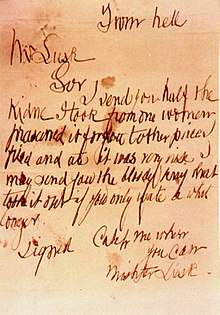
Correspondence
On 1 October, a postcard, dubbed the "Saucy Jacky" postcard and signed "Jack the Ripper", was received by the Central News Agency. It claimed responsibility for Stride's and Eddowes's murders, and described the killing of the two women as the "double event", a designation which has endured.[51] It has been argued that the postcard was mailed before the murders were publicised, making it unlikely that a crank would have such knowledge of the crime,[52] but it was postmarked more than 24 hours after the killings took place, long after details were known by journalists and residents of the area.[53] Police officials later claimed to have identified a journalist as the author of the postcard,[54] and dismissed it as a hoax,[55] an assessment shared by most Ripper historians.[56]
On 16 October 1888 a parcel containing half a human kidney accompanied by a note was received by George Lusk, Chairman of the Whitechapel Vigilance Committee. The note has become known as the "Lusk letter" or the "From hell" letter, because of the phrase "from hell" used by the writer, who claimed to have "fried and ate" the missing kidney half.[57] The handwriting and style were unlike that of the "Saucy Jacky" postcard. The kidney was taken to Dr Thomas Horrocks Openshaw at the nearby London Hospital. He believed that the kidney was human, from the left side, and preserved in spirits.[58] The Daily Telegraph reported on 19 October that he said it was a recent "ginny kidney" from a 45-year-old female, but in the Star newspaper the same day Openshaw denied the report strongly, saying it was impossible to detect the age or gender of the individual whom the kidney had belonged to,[59] or how long it had been preserved in spirits.[n 2]
Major Henry Smith claimed in his memoirs that the sent kidney matched the one missing from Eddowes, because the length of renal artery attached to the kidney matched the missing length from the body, and both the body and kidney showed signs of Bright's disease. Smith's later recollection does not match the medical reports submitted by the examining pathologists or the police records.[61] Police surgeon Dr Brown said that the kidney had been trimmed up, and that the renal artery was entirely absent.[62] Metropolitan police memos state that the kidney could have come from any body, such as those found in a hospital morgue.[63]
Smith's account is thought by historians to be dramatic licence on his part, and the kidney could have been a medical student's prank.[64] Dr Saunders, who attended the post-mortem, told the press, "the right kidney of the woman Eddowes was perfectly normal in its structure and healthy ... my opinion is that it was a student's antic."[65] Chief Inspector Donald Swanson, who co-ordinated the inquiry, wrote: "similar kidneys might and could be obtained from any dead person upon whom a post mortem had been made for any cause, by students or dissecting room porter."[66]
DNA analysis
In 2014, mitochondrial DNA that matched that of one of Eddowes's descendants was extracted from a shawl said to have come from the scene of her murder. The DNA match was based on one of seven small segments taken from the hypervariable regions.[67] The segment contained a sequence variation described as 314.1C, and claimed to be uncommon, with a frequency of only 1 in 290,000 worldwide. However, Professor Sir Alec Jeffreys and others pointed out this was in fact an error in nomenclature for the common sequence variation 315.1C,[68] which is present in more than 99% of the sequences in the EMPOP database.[69]
Other DNA on the shawl matched DNA from a relation of Aaron Kosminski, one of the suspects. This match was also based on a segment of mitochondrial DNA,[70] but no information was given that would enable the commonness of the sequence to be estimated.
The owner of the shawl, British author Russell Edwards, claimed the matches proved Kosminski was Jack the Ripper. Others disagree. Donald Rumbelow criticized the claim, saying that no shawl is listed among Eddowes's effects by the police,[71][72] and mitochondrial DNA expert Peter Gill said the shawl "is of dubious origin and has been handled by several people who could have shared that mitochondrial DNA profile."[71] Two of Eddowes's descendants are known to have been in the same room as the shawl for 3 days in 2007, and, in the words of one critic, "The shawl has been openly handled by loads of people and been touched, breathed on, spat upon."[71]

Funeral
Catherine Eddowes was buried on Monday, 8 October 1888 in an elm coffin in the City of London Cemetery, in an unmarked (public) grave 49336, square 318. Kelly and Eddowes's sister attended.[73] Today, square 318 has been re-used for part of the Memorial Gardens for cremated remains. Eddowes lies beside the Garden Way in front of Memorial Bed 1849. In late 1996, the cemetery authorities decided to formally mark Eddowes's grave with a plaque.[74]
Media
Film
- A Study in Terror (1965). This film casts Kay Walsh as Catherine Eddowes.[75]
- Love Lies Bleeding (1999). A drama film directed by William Tannen. Eddowes is portrayed by Elin Spidlová.
- From Hell. (2001). Directed by the Hughes Brothers, the film casts Lesley Sharp as Catherine Eddowes.[76]
Literature
- Begg, Paul (2014). Jack the Ripper: The Forgotten Victims. London: Yale University Press. ISBN 978-0-300-11720-2
- Evans, Stewart P.; Skinner, Keith (2001). Jack the Ripper: Letters from Hell. Stroud, Gloucestershire: Sutton Publishing. ISBN 0-7509-2549-3
Television
- Jack the Ripper (1973). A six-part BBC television drama series. This series casts Hilary Sesta as Catherine Eddowes.[77]
- Jack the Ripper (1988). A Thames Television film drama series starring Michael Caine. Catherine Eddowes is played by actress Susan George.[78]
- The Real Jack the Ripper (2010). Directed by David Mortin, this series casts Sarah Williamson as Catherine Eddowes and was first broadcast on 31 August 2010.[79]
- Jack the Ripper: The Definitive Story (2011). A two-hour documentary which references original police reports and eyewitness accounts pertaining to the Whitechapel Murderer. Eddowes is portrayed by Caroline Waite.[80]
Drama
- Jack, the Last Victim (2005). This musical casts Janet Wheeler as Catherine Eddowes.
See also
- Cold case
- List of serial killers before 1900
- Unsolved murders in the United Kingdom
Notes
- Watkins was to later testify at the formal inquest into Eddowes's death that his initial impression upon viewing her body was that it had been "cut up like a pig in the market".[27]
- In an interview given to the Sunday Times, published on 21 October 1888, Dr Frederick Gordon Brown stated the portion of Kidney sent to George Lusk on 16 October had "not been [preserved] in spirits for more than a week", adding the section of kidney displayed no signs of decomposition. Brown then elaborated: "As it exhibits no trace of decomposition, when we consider the length of time that has elapsed since the commission of the murder, we come to the conclusion that the probability is slight of its being a portion of the murdered woman of Mitre Square."[60]
References
- The Crimes, Detection and Death of Jack the Ripper ISBN 978-1-566-19537-9 p. 71
- Evans and Rumbelow, pp. 96–113
- Evans and Rumbelow, pp. 114–140
- Jack the Ripper: The Definitive History ISBN 978-1-405-80712-8 p. 211
- Jack the Ripper: The Definitive History ISBN 978-1-317-86633-6 p. 235
- Jack the Ripper: The Facts ISBN 978-0-760-77121-1 p. 165
- Jack the Ripper: The Definitive History ISBN 978-1-317-86633-6 p. 235
- Casebook: Jack The Ripper
- Inquest testimony of lodging-house deputy Frederick William Wilkinson, quoted in Evans and Skinner, p. 218 and Marriott, p. 136
- Naming Jack the Ripper: New Crime Scene Evidence, A Stunning Forensic Breakthrough ISBN 978-1-447-26423-1 p. 60
- Begg (2006), pp. 166–167; White, pp. 323–349
- Fido, p. 67
- Begg, Jack the Ripper: The Facts, p. 275
- Fido, p. 68
- Evans and Rumbelow, p. 114
- Evans and Skinner, p. 197; Fido, p. 67
- Evans and Rumbelow, pp. 114–115
- Evans and Rumbelow, p. 115; Evans and Skinner, pp. 209–210; Fido, p. 43
- Evans and Rumbelow, p. 116; Evans and Skinner, pp. 195, 210
- Evans and Skinner, p. 195; Fido, p. 43
- Jack the Ripper: The Facts ISBN 978-0-760-77121-1 p. 171
- Fido, pp. 43–45
- Evans and Rumbelow, p. 122
- Evans and Skinner, p. 185
- Evans and Rumbelow, p. 120; Fido, p. 44
- Evans and Rumbelow, pp. 117; Fido, p. 45
- Foul Deeds and Suspicious Deaths in London's East End ISBN 978-1-939-43000-7 p. 88
- Evans and Rumbelow, p. 120; Evans and Skinner, p. 211; Fido, p. 45
- Evans and Rumbelow, p. 122; Evans and Skinner, p. 212; Fido, p. 45
- Jack the Ripper: An Encyclopedia ISBN 978-1-844-54982-5 p. 52
- Medical report in Coroner's Inquests, no. 135, Corporation of London Records, quoted in Evans and Skinner, pp. 204–205 and Fido, pp. 46–47
- Medical report in Coroner's Inquests, no. 135, Corporation of London Records, quoted in Evans and Skinner, pp. 205–207 and Fido, pp. 70–74
- e.g. testimony of Dr Brown, quoted in Marriott, p. 145
- Letter from Thomas Bond to Robert Anderson, 10 November 1888, HO 144/221/A49301C ff. 220–223, quoted in Evans and Skinner, pp. 360–362 and Rumbelow, pp. 145–147
- Sequeira's inquest testimony quoted in Evans and Rumbelow, p. 128; Evans and Skinner, p. 208; Fido, p. 75; and Marriott, p. 144; Saunders's inquest testimony quoted in Evans and Skinner, p. 208 and Fido, p. 75
- Evans and Rumbelow, p. 129
- Camps, Francis E. (April 1966) "More About Jack the Ripper", London Hospital Gazette, reprinted in the February 1968 edition of The Criminologist, quoted in Wilson and Odell, p. 123
- Camps in Medical News, quoted in Wilson and Odell, p. 123
- Marriott, pp. 132–144; Whitehead and Rivett, p. 68
- "Daily News United Kingdom". 2 October 1888. Retrieved 15 May 2020.
- Evans and Skinner, p. 223
- Evans and Skinner, pp. 194–197; Fido, p. 67
- Evans and Skinner, p. 199; Marriott, p. 134; Wilson and Odell, p. 41
- Evans and Skinner, p. 202; Wilson and Odell, p. 42
- Evans and Rumbelow, p. 132; Fido, pp. 47–49
- Letter from Charles Warren to the Home Office Undersecretary of State, 6 November 1888, quoted in Begg (2003), p. 197; Evans and Skinner, pp. 183–184 and Marriott, p. 159
- Fido, p. 77; Marriott, p. 127
- Inquest testimony of surveyor Frederick William Foster, quoted in Evans and Skinner, pp. 201–202, 220 and Fido, p. 76
- Fido, pp. 50, 120
- Evans and Rumbelow, p. 133
- Evans and Skinner, p. 30; Rumbelow, p. 118
- e.g. Cullen, Tom (1965), Autumn of Terror, London: The Bodley Head, p. 103
- Cook, pp. 79–80; Fido, pp. 8–9; Marriott, pp. 219–222; Rumbelow, p. 123
- Cook, pp. 94–95; Evans and Skinner, pp. 624–633; Marriott, pp. 219–222; Rumbelow, pp. 121–122
- e.g. Letter from Charles Warren to Godfrey Lushington, 10 October 1888, Metropolitan Police Archive MEPO 1/48, quoted in Cook, p. 78; Evans and Rumbelow, p. 140 and Evans and Skinner, p. 43
- e.g. "the majority view of the Ripper historians, myself included, is that all the Ripper correspondence was fake." Beadle, William (2009) Jack the Ripper: Unmasked, London: John Blake, ISBN 978-1-84454-688-6, p. 168
- Evans and Rumbelow, pp. 167–168
- Fido, p. 78
- Cook, p. 146; Fido, p. 78
- Begg, Jack the Ripper: The Facts, p. 213
- Cook, pp. 147–148; Evans and Rumbelow, p. 168; Fido, pp. 78–79
- Cook, p. 148; Evans and Rumbelow, p. 168; Evans and Skinner, p. 189
- Evans and Rumbelow, p. 168; Evans and Skinner, p. 187; Fido, pp. 78–79
- Evans and Rumbelow, p. 168; Fido, pp. 78–79
- Manchester Evening News, 19 October 1888, quoted in Evans and Rumbelow, p. 168; Evening News, 20 October 1888, quoted in Fido, pp. 79–80
- Home Office report quoted in Evans and Rumbelow, p. 170 and Fido, p. 79
- Edwards, kindle locations 2442–2485
- Connor, Steve (19 October 2014). "Jack the Ripper: Scientist who claims to have identified notorious killer has 'made serious DNA error'". The Independent.
- "EMPOP.org – Mitochondrial DNA Control Region Database". EMPOP. Retrieved 8 October 2014.
- Edwards, kindle location 3506
- Burgess, Kaya (8 September 2014). "DNA row over 'proof' Aaron Kosminski was Jack the Ripper". The Australian.
- Satherley, Dan (8 September 2014). "Jack the Ripper: Mystery solved?". 3 News. Archived from the original on 8 September 2014. Retrieved 9 September 2014.
- Evans and Skinner, p. 225
- "Wolverhampton Jack the Ripper Victim Remembered". Express and Star. 2 July 2015. Retrieved 26 April 2020.
- "A Study in Terror (1965)". British Film Institute. Retrieved 3 December 2018.
- "Lesley Sharp". Guildhall School of Music & Drama. Retrieved 3 December 2018.
- Great Cinema Detectives: Best Movies of Mystery, Suspense & Film Noir ISBN 978-1-847-28685-7 p. 143
- "Jack the Ripper Part 2 (1988)". BFI. Retrieved 26 April 2020.
- "The Real Jack The Ripper (2010)". imdb.com. 31 August 2010. Retrieved 8 March 2020.
- "Jack the Ripper: The Definitive Story". guidedoc.tv. Archived from the original on 28 March 2019. Retrieved 26 April 2020.
Bibliography
- Begg, Paul (2003). Jack the Ripper: The Definitive History. London: Pearson Education. ISBN 0-582-50631-X
- Begg, Paul (2006). Jack the Ripper: The Facts. Anova Books. ISBN 1-86105-687-7
- Bell, Neil R. A. (2016). Capturing Jack the Ripper: In the Boots of a Bobby in Victorian England. Stroud: Amberley Publishing. ISBN 978-1-445-62162-3
- Cook, Andrew (2009). Jack the Ripper. Stroud, Gloucestershire: Amberley Publishing. ISBN 978-1-84868-327-3
- Eddleston, John J. (2002). Jack the Ripper: An Encyclopedia. London: Metro Books. ISBN 1-84358-046-2
- Edwards, Russell (2014). Naming Jack the Ripper. London: Sidgwick and Jackson
- Evans, Stewart P.; Rumbelow, Donald (2006). Jack the Ripper: Scotland Yard Investigates. Stroud, Gloucestershire: Sutton Publishing. ISBN 0-7509-4228-2
- Evans, Stewart P.; Skinner, Keith (2000). The Ultimate Jack the Ripper Sourcebook: An Illustrated Encyclopedia. London: Constable and Robinson. ISBN 1-84119-225-2
- Fido, Martin (1987). The Crimes, Death and Detection of Jack the Ripper. Vermont: Trafalgar Square. ISBN 978-0-297-79136-2
- Honeycombe, Gordon (1982). The Murders of the Black Museum: 1870-1970, London: Bloomsbury Books, ISBN 978-0-863-79040-9
- Marriott, Trevor (2005). Jack the Ripper: The 21st Century Investigation. London: John Blake. ISBN 1-84454-103-7
- Rubenhold, Hallie (2019). The Five: The Untold Lives of the Women Killed by Jack the Ripper. London: Doubleday. ISBN 978-0-857-52448-5
- Rumbelow, Donald (2004). The Complete Jack the Ripper. Fully Revised and Updated. Penguin Books. ISBN 978-0-14-017395-6
- White, Jerry (2007). London in the Nineteenth Century. London: Jonathan Cape. ISBN 978-0-224-06272-5
- Whitehead, Mark; Rivett, Miriam (2006). Jack the Ripper. Harpenden, Hertfordshire: Pocket Essentials. ISBN 978-1-904048-69-5
- Whittington-Egan, Richard; Whittington-Egan, Molly (1992). The Murder Almanac. Glasgow: Neil Wilson Publishing. ISBN 978-1-897-78404-4
- Wilson, Colin; Odell, Robin (1987) Jack the Ripper: Summing Up and Verdict. Bantam Press. ISBN 0-593-01020-5
External links
| Wikimedia Commons has media related to Catherine Eddowes. |
- Contemporary news article pertaining to te murder of Catherine Eddowes
- Casebook: Jack the Ripper
- The Whitechapel Murder Victims: Catherine Eddowes at whitechapeljack.com